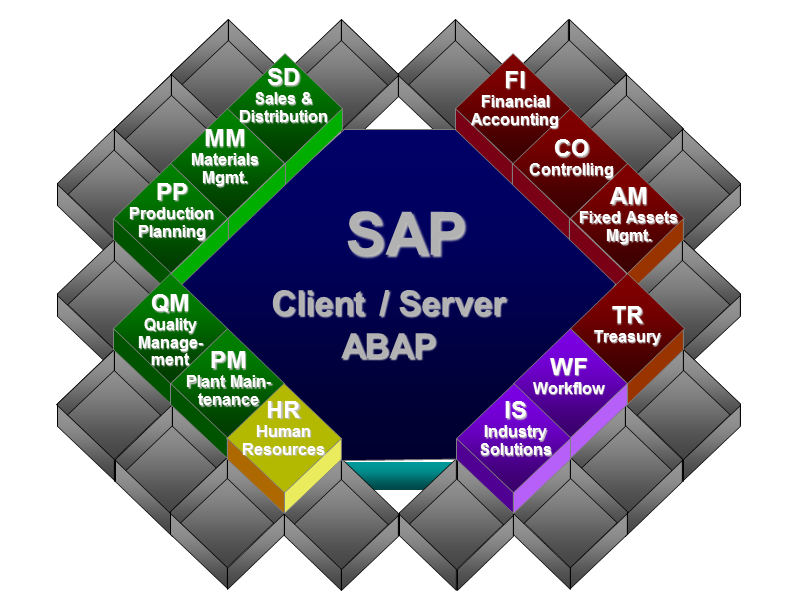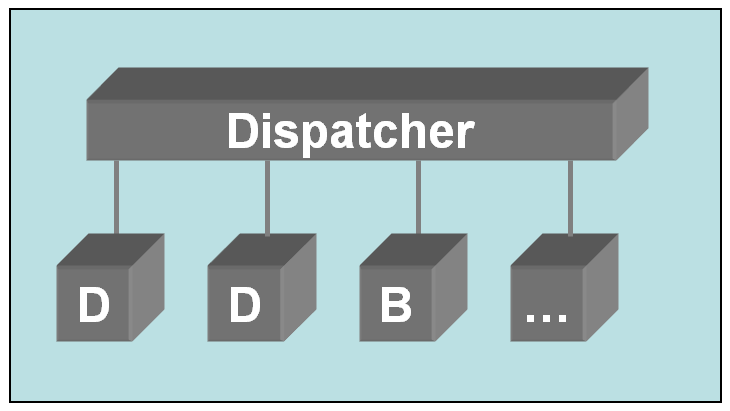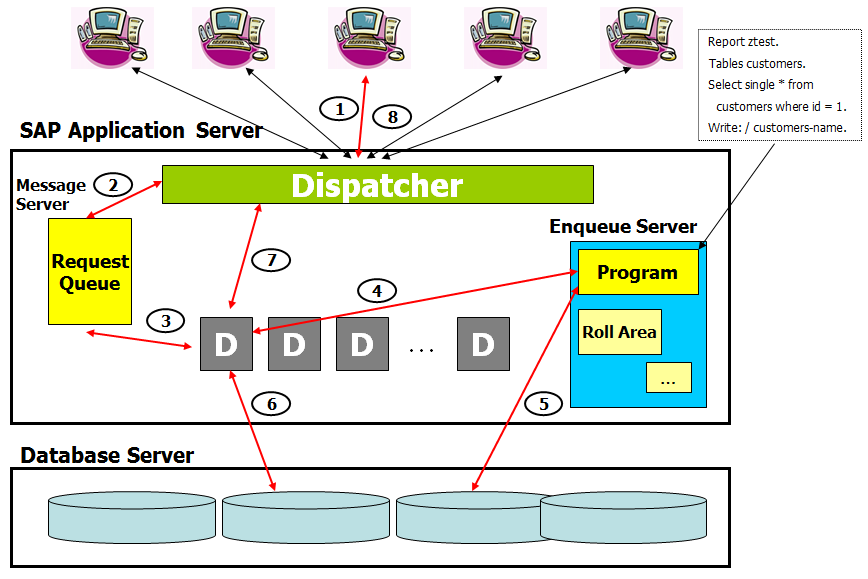Sap Or Erp Computer System Training
SAP software products provide powerful instruments for helping companies to manage their financials, logistics, human resources, and other concern areas. The backbone of SAP software offering is SAP ERP system which is the most advanced Enterprise Resources Planning (ERP) system from currently available ones. SAP has evolved to offer awarding software for supporting complex concern functionality and in this post we are going to explain (on high level) how does SAP work.
SAP System Architecture
It is a proficient idea to start answering the question "How Does SAP Piece of work?" with a discussion of what the components of an SAP ERP organization are, how they are related to each other, and what are their purposes. We should mention that SAP ERP is not the just SAP software component. At that place are other business organisation application components such as Business Intelligence (BI), Supply Chain Management (SCM), and Customer Relationship Management (CRM). Even so, in this commodity we are going to focus on SAP ERP because information technology is the primary component and provides capabilities for integrating business data from other application components.
SAP ERP system is ordinarily structured in a iii-tier customer/server architecture. The 3-tier architecture is the recommended one because it enables high scalability and flexibility but SAP can besides be deployed on two- and one-tier architectures. Figure 1 provides a graphical illustration of the differences between these architectures.

In the three-tier SAP compages, the presentation tier provides the interface to the user, the awarding tier processes the business logic, and the database tier stores the business data.
The Presentation Tier
The presentation tier is typically located on PCs of business organisation users and provides the SAP Graphical Interface (SAP GUI). SAP GUI is a lightweight application that can be installed on any computer running MS Windows or Mac Bone and it provides the interface for communication betwixt the user and the SAP ERP organization.
The Application Tier
The application tier is basically the centre of the SAP ERP system. It executes the business logic, responsible for processing client transactions, print jobs, running reports, coordinating access to the database, and interfacing with other applications. It is possible to distribute the application logic between several server machines in situations when the load exceeds processing ability of a single server.
The Database Tier
The database is used for storing two types of objects: the concern-generated information and the SAP application programs. The business-generated data represents information objects created past users every bit function of various business processes. For instance, sales orders or customer main records are classified as the business organisation-generated data. SAP application programs are routines written in ABAP (special programming language used in SAP) that are loaded into the SAP application servers from the database at runtime.
Information technology is possible to use databases from different vendors (for instance, Oracle or Microsoft) and it is up to the visitor to decide which database vendor to cull. Unremarkably, the database license is included into the price of SAP. The database tier has the highest requirements for availability, reliability, and performance because usually each SAP system is deployed on i database instance. Therefore, performance of the database tier ultimately determines the scalability of the entire SAP ERP installation.
There are situations when three tiers can be reduced to two or one. The possibility of these situations depends on available processing power and number of business users. For example, it is possible to install all three SAP tiers on a single computer for demo purposes. On the other mitt, big SAP productive installations require multiple powerful servers for each of the tiers in society to ensure good performance of the SAP arrangement.
Above these tiers, SAP architecture can be farther segmented into several awarding modules. Each module contains the SAP application programs and business information related to a specific business area such as fiscal bookkeeping (FI) or materials direction (MM). Figure two illustrates the awarding modules which are included into the SAP ERP organisation.

Although SAP awarding modules cover completely dissimilar business organization process and business organization areas, technically they piece of work in a similar style. The deviation is only in ABAP programs and information tables that are used in each of these modules of SAP. For this reason, our article is not going to focus on whatsoever detail SAP module merely will instead explain how does SAP work with the three-tier architecture in general.
How Does SAP Work?
Now that we know what are the components and tiers of the SAP ERP arrangement, allow u.s. encounter how does SAP work. As it was explained above, the heart (or kernel) of the SAP arrangement is in the application tier (application server). The application server gets input from and displays output to the presentation tier (SAP GUI). Furthermore, information technology stores data in the database tier.
SAP Kernel
The kernel of the SAP system is a collection of executables programs and auxiliary tools for processing the business logic. All kernel processes that are started or stopped are called an SAP instance. SAP ERP system typically contains several instances in such a style that each instance is running on a dedicated server computer.
Each SAP example contains a dispatcher and several work processes. The dispatcher distributes tasks to one of the piece of work processes. The SAP system has different kinds of work processes that were created for diverse tasks. Here is the listing of their types:
- D: Dialog work processes which are responsible for handling online transactional requests from users.
- B: Batch work processes which are responsible for processing background jobs scheduled in the SAP organisation.
- V: Update work processes which are responsible for carrying out updates in the database. These updates tin happen asynchronously to batch and dialog processes.
- S: Spool piece of work processes which are responsible for enabling printing in the SAP system.
- 1000: Gateway work processes which are responsible for enabling communication between applications (for example, between SAP R/3 and SAP R/ii). Only one gateway work process is needed per i SAP arrangement.
Figure 3 illustrates a generic SAP awarding instance with one dispatcher and several work processes.

As we said above, the SAP ERP organisation tin can contain several SAP application instances merely among these instances at that place must exist one special example chosen the key instance (CI). The primal instance has two additional components called the message process (Yard) and the enqueue server (E).
The message process (M) of the central example is used for establishing communication between various application instances included in the SAP organisation. For instance, when a user logins to the SAP system, information technology is automatically assigned by the message process to one of the available application instances. Next, all the transactional requests related to this user will exist re-routed past the message process to the chosen awarding instance.
The enqueue server (E) of the primal example is used for managing locks on the database tables. These locks ensure that database updates are performed in a proper sequence and guarantee consistency of the business data.
The key instance is schematically illustrated on Figure 4.

How Does SAP Work?
SAP organisation works in the following way:
- A request arrives from the presentation tier (it can exist an online request from a user or a request related to a batch job or anything else).
- This request is analyzed by the dispatcher of the SAP central example.
- The dispatcher passes the request to the bulletin process (1000).
- The message procedure (Yard) decided whether this request should exist processed on this instance or needs to be forwarded to a different instance (for example, an example with a lower computing load).
- If the request remains at the aforementioned instance, information technology is put in one of the work processes of the appropriate type (for instance, if information technology an online asking from a user, it should exist placed in the dialog work procedure).
- The request gets processed by the piece of work procedure, and if necessary, the SAP organisation will commit an update to the database through the enqueue server (E).
- The feedback about outcome of the asking is delivered back to the originator of the request in a reversed social club.
This explanation of how does SAP work could exist a little bit hard to follow, and therefore, let usa consider a simple example that will hopefully make agreement easier.
In our instance, a business concern user runs a transaction called ZREPORT (it a fake transaction just for this case). This transaction selects one customer from the table with customers and changes its proper name. We are interested to see what happens in the SAP ERP system when the business organization user executes this simple transaction. Figure 5 provides an illustration of how SAP works in this example.

According to Effigy 5, the SAP ERP arrangement receives input via SAP GUI from a concern user. This user launched the transaction. Side by side, the system procedure this input in a number of steps:
- The input is passed to the dispatcher of the central instance.
- The dispatcher passes the request to the message procedure (1000).
- The message process (M) placed the request into i of the dialog piece of work processes (D).
- The dialog work process (D) performs reading and update of the database through the enqueue server (Due east).
- The enqueue server (E) passes the update request to the database (it is necessary to update name of the client).
- The database returns feedback to the dialog work process (D).
- The dialog work process (D) passes the feedback to the dispatcher.
- The dispatcher returns the outcome of the operation to the presentation tier (SAP GUI) and the business user sees the outcome on her screen.
Hopefully, this unproblematic case will help y'all to understand the full general principle of how does SAP work. Of form, in the real life, in that location are millions of technical details and nuances that are only known to SAP basis experts. All the same, this explanation should be a skillful starting point for everyone who wants to understand the basic technical principles of how does SAP piece of work.
Summary
In this postal service, nosotros attempted to explain how does SAP work. We tried to avoid difficult technical details and proceed the explanation easy for agreement. We first had to depict SAP architecture and diverse components of the organisation. Side by side, we explained and illustrated with a unproblematic example how these components piece of work together and support business concern processes of an enterprise. Your feedback is very important for us, so if you lot liked the article, please bookmark information technology in social networks and exit a comment below.
Sap Or Erp Computer System Training,
Source: https://erproof.com/how-does-sap-work/
Posted by: mitchellvater1965.blogspot.com


0 Response to "Sap Or Erp Computer System Training"
Post a Comment